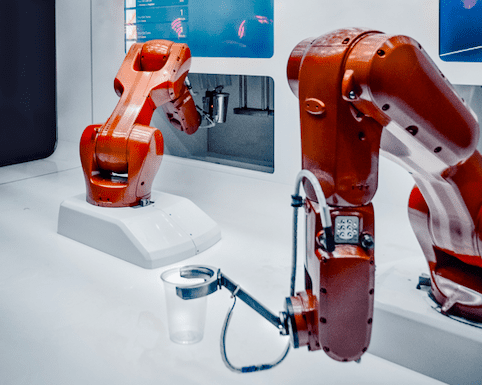
15 modern tech terms you should know

What are some of the most important modern tech terms? With technology advancing fast it can be hard to keep up with the latest developments. If you don’t make an active effort to learn them, you might get left behind. Here, we discuss some of the most important tech terms and what they mean.
1. AI
What is AI?
Artificial Intelligence, (AI) is likely to be one of the most important tech terms of the 21st century. As society becomes ever-reliant on machines, it is AI that will be behind the most significant technological advancements.
Put simply, Artificial intelligence is intelligence demonstrated by machines. It is the ability of machines to replicate some of the cognitive functions of the human (or animal) brain and make decisions accordingly.
Examples of AI in everyday use include:
- Siri
- Alexa
- Self-driving cars (like those produced by Tesla)
- Google maps
- Autocorrect
AI is what allows your phone to correct your bad spelling. It has also been used more recently in apps like Google maps. Not to work out your route (which is done through GPS) but to assess, in real-time, which roads are likely to have traffic jams, based on phone signals on roads in a particular area.
Perhaps the first introduction to AI for most was the IBM machine Deep Blue. In 1997, it beat chess grandmaster Garry Kasparov in a chess match. Becoming the first AI machine to ever win a game against a human and effectively outthink the famous chess champion.
How can AI be used to make better hires in HR ? – Read more
2. Automation
What is automation?
Automation involves reducing the level of input required by a human within a process. AI is an advanced form of automation. However, automation can be much simpler and is common in everyday modern life.
Perhaps you drove to work this morning in an ‘automatic’ transmission car, rather than a car with a manual transmission. The car doing part of the job of the driver is an example of automation. Your kettle knowing when the water is boiled is automation. As is your washing machine knowing how to wash your clothes. While DevSkiller TalentScore uses automation in developer screening tests to automatically assess a candidate’s results — taking the job off the hands of the recruiter.
Learn more about DevSkiller TalentScore
Automation is nothing new, but it is becoming more advanced and prevalent in everyday society. More human tasks are now being performed by machines — and with alarming skill. In the future, huge sectors of the customer service and HR sectors, in particular, will be performed by machines. This can already be seen in the case of self-service fast-food restaurants and in areas of technical recruitment.
Automation can also be used nowadays to foster partner relationship management. One example is the acceleration of the partner onboarding process, which captures information about the new partner’s corporate entity more quickly and by automated means.
에 따르면 Ideal, “7% of HR managers think a robot could do their job.”

Photo by Alex Knight on Unsplash
AI vs Automation – What’s the difference?
If you’re now thinking, ‘what’s the difference between AI and automation?’ that’s understandable, the two often get confused with one another. To put it simply, automation is using machines to do the work of humans. Whereas AI is getting machines to think like humans.
“AI mimics human intelligence decisions and actions, while automation focuses on streamlining repetitive, instructive tasks.” – Corinium intelligence
3. Big Data
What is Big Data?
Data is a valuable commodity and businesses are scrambling to get hold of as much as possible. The fact that it appears several times in this list should be a good indicator. Significant amounts of data are collected as part of Big data. Amounts so large they can only be collected and properly analyzed using computer databases.
Big Data is not a new term. In fact, it was first coined by Chief Scientist at Silicon Graphics, John Mashey in the 1990s. The term started to gather traction after 2001, when Doug Laney divided Big Data into three discernible categories – volume, velocity and variety.
Sources for Big Data come from all corners of the internet. The data is usually broken down into social data —meaning likes and shares on social media, and machine data —meaning and transactional data.
Read- The key roles of a modern data-driven organization
4. Data mining
What is data mining?
Going one step further from Big Data, mentioned above, data mining is the process of analyzing large amounts of collected data to look for patterns that can then be used to make business predictions for the future. Using software, algorithms and statistics, data experts can search for patterns and anomalies to answer business-related questions. Marketing companies, banks and cyber-security firms, are all likely to implement data mining now and going forward.
5. Data Science
What is data science?
Data science is an umbrella term used to describe the various different ways to collect data. The process is more heavily involved with the technical aspects of data collection than data mining for instance. Data scientists are often in charge of creating the processes and tools by which data can be collected, as opposed to analyzing the data. Big data and data mining, are both incorporated into the overall term of data science.
Read – How to screen data-science skills
6. Blockchain
What is Blockchain?
Blockchain is the technology behind nearly all cryptocurrencies. It also has the potential to go even further. Blockchain is a person-to-person system that offers increased security from hackers. It works by storing data over a series of computers or “blocks”, that are then spread over a distributed network creating a secure “chain.”
Who invented blockchain?
Blockchain was invented in 2008 by Satoshi Nakamoto — a presumed pseudonym. This was the same person who invented BitCoin.
What is blockchain used for?
At the moment Blockchain is most commonly used in the transfer of cryptocurrencies, but in the future, it could be used to record ownership in the transfer of assets, like real estate, and even implemented into voting procedures to eliminate paper ballots and vote tampering.
How much does a Blockchain developer earn?
Source Morthy Jameson on Unsplash
7. Business Intelligence
What is business intelligence?
Business intelligence is part of a larger process that includes implementing the tools and infrastructure for collecting and analyzing large amounts of data and using this to produce financial reports and make key business decisions.
Part of business intelligence is automating the collection of data on a large scale, so results can be drawn from thousands of sources- more than could ever be collected manually, and decisions can be made based on the findings.
8. Cloud computing
What is cloud computing?
Cloud computing is the process of providing IT services over the internet. Most commonly it is used for data storage, but entire networks, databases and software can also be shared over cloud networks. Google Cloud, Amazon Web Services, Microsoft Azure and Apple’s iCloud are all well-known cloud computing services.
Snowflake cloud data warehouse
Snowflake is another cloud computing company that provides cloud-based data storage. It offers an alternative to the tech giants of Apple, Microsoft, Google, and Amazon.
Read – What is a cloud architect?
9. Internet of Things
What is the IoT?
The Internet of Things (or Internet of everything) – is a term used to describe objects with the ability to connect to the internet. To further explore the practical applications of this technology, one can consider the expertise of iot development services, which specialize in bringing these interconnected devices to life. Either through sensors, software, or built-in technology. Due to devices like Google home mini, entire smart homes are now in existence, where lights, heating, and door locks are all controlled through the internet.
Everyday examples of the IoT include –
- Motion sensor baby monitor
- Smart TVs
- Amazon dash button/ Amazon echo
- Smart home devices
- Doorbell cameras
- Children’s smart toys
- Digital piggy banks
- Smart clothing
Why does IoT matter?
Photo by Ihor Saveliev on Unsplash
IoT matters because it has the potential to improve our everyday lives exponentially. It offers the ability to control every aspect of daily life thanks to a few sensors. The potential is that almost every item in a household can and will, eventually be connected to the internet.
10. Web of Things
What is the Web of Things?
Ironically, the IoT is similar but not quite the same as the WoT (Web of Things). The WoT could effectively be called a continuation of the IoT. A future where any everyday object is connected to the web. At the moment, IoT products like Alexa and Amazon dash, might connect with each other and other Amazon ‘things’, but they won’t connect to just any internet-enabled device.
The WoT would see every internet-enabled item connected to the web universally.
“The Web of Things (WoT) seeks to counter the fragmentation of the IoT by using and extending existing, standardized Web technologies.” W3.org
11. Metaverse
What is Facebook meta?
The term ‘meta’ was cemented into the minds of many around the world after the social media tech giant changed its name from Facebook to Meta in 2021. However, the Facebook metaverse is only one of many metaverses that are, and will, come into existence in the coming years.
What is a metaverse?
A metaverse is a virtual universe accessed through augmented reality and connected to other virtual spaces through the internet.
Metaverse gamers made famous what was perhaps the first well-known example of a metaverse in 2003, with Second Life. Since then metaverse capabilities and the worlds they encompass, have grown exponentially. Metaverse expectations are that within the next few decades virtual meeting places and virtual offices will become commonplace as places for people to work and socialize, as an alternative to reality.
Source- flickr– A class in progress in Second Life
12. Machine learning
How does machine learning work?
Machine learning works by creating programs with advanced algorithms that allow them to effectively learn from the past and come up with new solutions to problems. Machine learning is a part of artificial intelligence and primarily focuses on machines being able to ‘think’.
The term is often linked to robotics, even though most robots are not artificially intelligent. Most are simply machines programmed to perform a task. However, some can demonstrate machine learning capabilities—Honda’s Asimo for instance. Machine learning is specifically focused on machines that are actively able to learn and adapt.
Read – How to screen machine learning skills
Asimo – Machine Learning – Photo by Possessed Photography on Unsplash
13. UX – User experience
What is UX?
UX (user experience) relates to how a person interacts with the features of a given product or program. A good user experience can come from interaction with an easy-to-use program. Whereas a bad UX might be from a program that is unnecessarily complicated and difficult to work with.
14. UI – User Interface
What is a UI?
UX should not be confused with UI (user interface). UI relates to a physical screen or display the user interacts with. A simple and well-laid-out UI can contribute to an overall positive UX, however, the two are not the same.
15. X reality (XR)
What is extended reality?
X reality (XR), or extended reality, is an umbrella term used to describe any world that exists outside of the scope of reality- including virtual reality, augmented reality and mixed reality.
What is virtual reality?
Photo by Jessica Lewis on Unsplash
Virtual reality is an entirely computerized, simulated world that is experienced, usually visually, through the use of VR headsets like Facebook’s Oculus. VR worlds can transport users to a new universe, or they can provide a simulation of the real world.
Companies like Roblox 및 Epic Games (creators of Fortnite) are at the forefront of developments in virtual reality.
Mixed reality vs Augmented reality
Photo by Patrick Schneider on Unsplash
Most can grasp the concept of virtual reality. The term has been around in virtual reality games for many years. However, knowing where mixed reality and augmented reality fit into the equation, can be a little trickier.
What is augmented reality?
Augmented reality (AR) involves adding virtual elements into a real-world setting. It is much more common in everyday life than you might realize. Examples of augmented reality in everyday life include Zoom backgrounds, Snapchat filters, and the popular game Pokemon Go.
What is mixed reality?
Mixed reality (MR) consists of elements from both virtual reality and augmented reality to create a hybrid world that blends the physical and the digital. Using a virtual reality type headset, users can find themselves interacting with a world that is part reality and part virtual. Microsoft is among the companies heavily involved in mixed reality, with the company’s mixed reality portal released in 2017.
Mixed reality is being used to train medical professionals for surgeries, and even to prepare soldiers for war.
Summary
The technological world is evolving quickly. As a result, new modern tech terms are being coined every day. This list has provided you with a basic understanding of only some of the main principles being explored by tech companies around the world. Moreover, whether it be virtual reality, machine learning, or diving deep into the metaverse, you should have enough to keep up with the conversation at your next dinner party.
Photo by Andy Kelly on Unsplash




